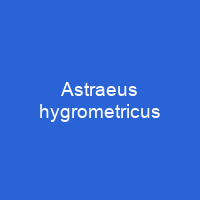
Astraeus hygrometricus, the Hygroscopic Earthstar: A Fungal Enigma
Imagine a fungus that can open its rays like a flower, revealing its secrets to the world based on humidity changes. This is Astraeus hygrometricus, the hygroscopic earthstar—a fascinating species with a complex history and a unique life cycle. How does this enigmatic fungus manage to change its appearance so dramatically? And what makes it so special that scientists are still unraveling its mysteries?
The Journey of A. Hygrometricus
Once thought to be cosmopolitan, the hygroscopic earthstar is now known to be restricted to Southern Europe and Asia. This species has a rich history, with its first description dating back to 1801 by Christian Hendrik Persoon as Geastrum hygrometricus. However, in 1889, Andrew P. Morgan reclassified it into the genus Astraeus due to its distinct characteristics. Despite this, Gordon Herriot Cunningham transferred it back to Geastrum in 1944, but recent molecular studies have confirmed that A. hygrometricus is a unique species within its own genus.
Microscopic Marvels and Bioactive Compounds
The hygroscopic earthstar has distinctive microscopic features and bioactive compounds that make it stand out from other fungi. Its spores, spherical or nearly so, are reddish-brown, thick-walled, and verrucose, measuring 7–11 μm in diameter with warts about 1 μm long. The capillitia are branched hyaline fibers dispersed among the spores, while the basidia are four- to eight-spored with short sterigmata.
Ecological and Edibility
Astraeus hygrometricus is an ectomycorrhizal fungus that grows in association with a variety of tree species such as oak, pine, chir pine, and sal. It can be found on open fields or rocks and typically appears in autumn, though it may persist for several years. In some regions, this earthstar is considered inedible due to its toughness, but in Nepal and Japan, it is a seasonal delicacy.
Edibility and Traditional Uses
The hygroscopic earthstar has been used in traditional Chinese medicine as a hemostatic agent. Two Indian forest tribes also use the fungus medicinally. The Blackfoot of North America have an interesting cultural connection, considering it ‘fallen stars.’ These diverse uses highlight the multifaceted role this species plays not only in nature but also in human culture.
New Discoveries and Molecular Studies
Recent research has identified new species within the Astraeus genus, including A. morganii, A. smithii, and A. pteridis. The European population of A. hygrometricus may be divided into two distinct phylotypes based on preliminary DNA analyses. Additionally, a Japanese species and a Korean-Japanese variant require further analysis to determine their proper names.
Asian Variants
The study of Asian Astraeus species has revealed that some specimens labeled as A. hygrometricus are actually variable in characteristics. Molecular analysis has identified two new Asian populations, and the spore ornamentation of these species is distinct from A. hygrometricus.
Comparative Analysis
Astraeus odoratus, A. asiaticus, and A. koreanus are similar to A. hygrometricus but can be distinguished based on microscopic and macroscopic characteristics. For instance, A. odoratus has a smooth outer mycelial layer with few adhering soil particles, 3–9 broad rays, and a fresh odor similar to moist soil.
Health Benefits
The health benefits of Astraeus hygrometricus are not just limited to traditional uses. Studies have shown that mushroom polysaccharides from this species have immunomodulatory and antitumor properties. Extracts containing AE2 inhibit tumor cell growth and stimulate immune cells, while polysaccharide AE2 is composed of mannose, glucose, and fucose.
Antioxidant and Anti-inflammatory Properties
Ethanol extracts from A. hygrometricus show high antioxidant activity and anti-inflammatory effects comparable to diclofenac. This earthstar has also been used traditionally as a hemostatic agent, salve for burns, and antiseptic treatment.
Conclusion
Astraeus hygrometricus is more than just an interesting fungus; it’s a living testament to the complexity of nature. From its unique life cycle to its diverse uses in traditional medicine, this species continues to captivate scientists and inspire wonder. As we continue to explore and understand these fascinating organisms, we uncover not only new species but also potential health benefits that could change our lives.
You want to know more about Astraeus hygrometricus?
This page is based on the article Astraeus hygrometricus published in Wikipedia (retrieved on November 25, 2024) and was automatically summarized using artificial intelligence.







